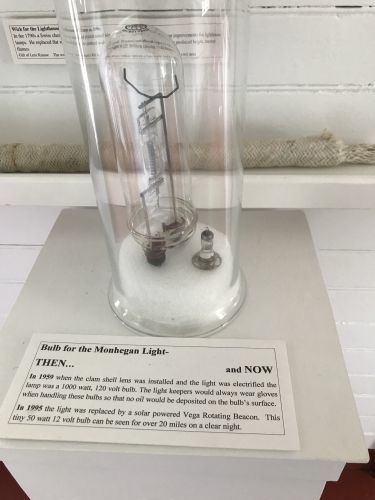Lighthouse physics

The photo shows two light bulbs used in lighthouses by the US Coast Guard. The larger one has 1000 W power and the smaller one only uses 50 W (making the automatic operation possible, with the use of solar energy). Can we save all that energy without compromising the safety?
To answer this question, consider two "model" light sources. The first one has 1000 W power. The light is emitted from the surface of a cylinder 5 cm long and 1 cm in diameter. The light source is placed in the focal plane of a lens with a focal length of 40 cm, and the diameter of the lens is 20 cm. The second light source has 50 W power, emitted from a cylinder of 5 mm length and 1 mm diameter. To make the light source more compact, we use a lens of 20 cm focal length, with a diameter of 10 cm.
The two sources are next to each other and they are viewed from a kilometer distance by a sailor.
Which one looks brighter, and how much brighter is it?
Assume that diffraction effects are not important.
This section requires Javascript.
You are seeing this because something didn't load right. We suggest you, (a) try
refreshing the page, (b) enabling javascript if it is disabled on your browser and,
finally, (c)
loading the
non-javascript version of this page
. We're sorry about the hassle.
Among other things, the brightness depends on what fraction of the emitted light is captured by the lens. If the lens covers a larger solid angle, the beam will be brighter. Since the focal lengths and the diameters of the two lenses both differ by a factor of 2, the solid angle is the same for the two lenses and there is no difference between the two light sources in this respect. This is not true for the other factors influencing the brightness.
The sailor's eye captures the light that enters the pupil of area A . If we trace back the light beams that arrive within this area, we will find that they came form an area of the surface of the light source that is A ′ = ( f / d ) 2 A , where f is the focal length and d > > f is the distance from the lighthouse. The power reaching the sailor is the product of this area and the power density (power per unit area) of the light source. By definition, the power density is p ′ = P ′ / A ′ , where P ′ is the total power of the light bulb and A ′ is the area emitting the light. Combining all of these together we get
P = p ′ A ′ = A ′ P ′ ( d f ) 2 A
The ratio of the powers reaching the sailor's eye is
P 2 P 1 = P 2 ′ P 1 ′ A 1 ′ A 2 ′ ( f 2 f 1 ) 2
This is independent of the distance d and the area of the sailor's pupil. Starting with the smaller source, f 1 = 2 0 cm, P 1 ′ = 5 0 W and for the second source f 2 = 4 0 cm, P 2 ′ = 1 0 0 0 W. The first factor is a disadvantage P 2 ′ P 1 ′ = 2 0 1 . The third factor is also bad, ( f 2 f 1 ) 2 = 4 1 . The ratio of the two surface areas is a big gain. Since all the linear dimensions are scaled by a factor of 10, the ratio of the two areas is A 1 ′ A 2 ′ = 1 0 0 . Overall, the smaller source is brighter by a factor of 1.25.